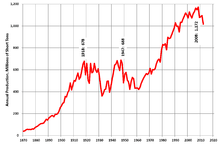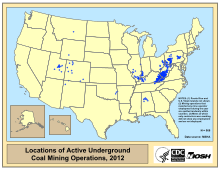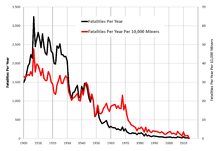Coal mining in the United States

Coal mining in the United States is a major industry, and reached an all-time high of 1.06 Gt (1.17 billion short tons) in 2008, being mined in 25 states, 40% on public lands. The U.S. was a net exporter of coal in 2008, with the surplus of exports over imports equaling 4% of the total mined. In 2010, coal exports increased to 7.5% of coal produced in the U.S. U.S. coal exports, for which Europe is the largest customer, peaked in 2012, and have declined since.[1] From 2015 to January 2016, four publicly traded US coal companies have declared bankruptcy, including the fourth-largest (Alpha Natural Resources) and second-largest producer (Arch Coal).[2]




History
Production
US coal production has steadily declined since 2008, with around 900m short tonnes produced 2015, the lowest since 1986.[3] Employment in the coal sector is the lowest since the 1980s.[4]
| Coal in the US (Mt)[5] | |||
|---|---|---|---|
| Production | Net export | Net available | |
| 2005 | 1,028 | 20 | 1,008 |
| 2008 | 1,076 | 43 | 1,033 |
| 2009 | 985 | 33 | 952 |
| 2010 | 997 | 57 | 940 |
| 2011 | 1,004 | 85 | 919 |
Coal mining has been roughly equal in volume (Mt) between 2005-2011 in the US. Coal available for own use as Mt was 91% in 2011 compred to 2005, which may reflect less coal dependency in the energy supply. One should also notice that the specific net calorific value for coal in the US was 0.541 toe/tonne in 2011 and 0.632 toe/tonne in 2004/2005. This means that less energy rich mines are used than earlier. 2011/2005-ratio is 86%.
Areas
As of 2005 twenty-seven states produced coal.[6] As of 2000 coal production in the United States totaled 1,437,174,000 short tons. The major coal-producing states were in descending order, with annual production in thousands of short tons:[7][8]
- Wyoming (338,900). (see Coal mining in Wyoming)
- West Virginia (158,257)
- Kentucky (130,688) (see Coal mining in Kentucky)
- Pennsylvania (74,619)
- Texas (49,498)
- Montana (38,352)
- Illinois (33,444)
- Virginia (32,834)
- North Dakota (31,270)
- Colorado (29,137) (see Coal mining in Colorado)
- Indiana (27,965)
- New Mexico (27,323)
- Utah (26,656)
- Ohio (22,269)
- Alabama (19,324)
- Arizona (13,111)
On 16 January 2016, the Obama administration announced it would stop issuing new coal mining leases on public land for 3 years effective immediately and leave around 20 years-worth of coal production under way.[9] This would affect 50 licenses.[3]
Export
The U.S. was a net exporter of coal in 2008, with the surplus of exports over imports equaling 4% of the total mined.[10] In 2010, coal exports increased to 7.5% of coal produced in the U.S.[11] As of 2013, while domestic coal consumption for power production was being displaced by natural gas, production for export to Asia from strip mines was increasing
As of 2013, five coal export terminals were in the planning stages in the Pacific Northwest.[12] They were scheduled to be supplied by strip mines in the Powder River Basin. The export market is China and other Asian nations. Like the Keystone Pipeline the building of the terminals raise environmental concerns with respect to global warming.[13]
Usage
More than 90 percent of the annually-mined coal in the United States is used by the US electrical power industry.[14] Since 2000, the growth of coal-fired power generation has slowed considerably from what it was in the late 1990s.[15]
As of 2012 coal accounted for 37% of electricity production in the United States, down from 50% in 2005.[16] In 2006, there were 1,493 coal-powered generating units at electrical utilities across the US, with total nominal capacity of 335.8 GW[17] (compared to 1024 units at nominal capacity of 278 GW in 2000).[18] Actual power generated from coal in 2006 was 227.1 GW (1.991 trillion kilowatt-hours per year),[19] the highest in the world and still slightly ahead of China (1.95 trillion kilowatt-hours per year) at that time.[20] In 2000, US production of electricity from coal was 224.3 GW (1.966 trillion kilowatt-hours per year).[19] In 2006, the US consumed 1,026,636,000 short tons (931,349,000 metric tons) or 92.3% of coal mined for electricity generation.[21]
As of 2013, domestic coal consumption for power production was being displaced by natural gas, but production from strip mines utilizing thick deposits in the western United States such as the Powder River Basin in northern Wyoming and Southern Montana for export to Asia increased.[22]
Regulation
The federal coal program is overseen by the Bureau of Land Management (BLM) under the US Department of Interior, and has not had a "top-down review" for the past 30 years.[3] In 2014, it generated about $1.2 billion for leases, royalties and other fees for coal mining on public lands. As of 2016, the leasing rate is $3 per acre, plus royalties paid on the market value of the coal when extracted.[4] BLM publishes little information on federal coal lease sales, also does not include their appraisal report, because some of this information is "sensitive and proprietary"; this violates BLM's own guidance.[23]:44
The Government Accountability Office has questioned whether lease and royalty rates reflect coal's market value. Per GAO, since 1990 Colorado earned about $22 million less from bonus bids than Utah, though Colorado leased out almost 76 million tons more coal than Utah.[23]:27 A Boston-based think tank, the Institute for Energy Economic & Financial Analysis study found that since 1991 almost all lease sales had only one bidder and that $29 billion over the last 30 years were lost.[24]
Energy value

The tonnage of mined coal hit a peak in 2008, and the energy value of mined US coal hit its all-time peak a decade earlier, in 1998, at 26.2 quadrillion BTU. The energy value of US coal mined in 2011 was 24.0 quadrillion BTU, 9 percent lower than the peak.[25]
According to International Energy Agency (IEA) statistics, the average energy value of a ton of coal mined in the United States in 2010 was only 85% of the average mined in 2009. The net calorific values of coal in the US were:[26]
- 2010 0.543 tonnes oil equivalent/tonne
- 2009 0.641 tonnes oil equivalent/tonne
- 2008 0.635 tonnes oil equivalent/tonne
- 2005 0.632 tonnes oil equivalent/tonne
| Coal in the US [27] | |||
|---|---|---|---|
| Mt | toe/tonne | TWh | |
| 2009 | 997 | 0.641 | 7,432 |
| 2010 | 985 | 0.543 | 6,220 |
| Mtoe = 11.63 TWh Confirm from the national statistics. | |||
Accidents

Opposition
Concern about global warming in the US [28] - especially in the aftermath of Hurricane Katrina and Al Gore's receipt of the 2007 Nobel Peace Prize for his raising awareness of climate change - temporarily increased public opposition to new coal-fired power plants.[29][30] Simultaneously with these events, the anti-coal movement in the US - similar to that in the UK and Australia - had made coal-fired power projects more politically costly, and spurred further shifts in public opinion against coal-fired power.[31][32][33]
In a 2004 effort to foster positive public opinion of coal, many large coal mining companies, electric utilities, and railroads in the U.S. launched a high-profile marketing campaign to convince the American public that coal-fired power can be environmentally sustainable.[34][35][36] However, some environmentalists condemned this campaign as a "greenwashing" attempt to use environmentalist rhetoric to disguise what they call "the inherently environmentally unsustainable nature of coal-fired power generation".[37]
See also
- American Coalition for Clean Coal Electricity
- Clean coal
- Coal mining
- Coal power in the United States
- Environmental effects of coal
- Greenhouse gas emissions by the United States
- History of coal mining in the United States
- Coal Creek War
Footnotes
- ↑ U.S. coal exports fall on lower European demand, increased global supply, US Energy Information Administration, 3 Oct. 2014.
- ↑ John W. Miller and Peg Brickley, “Arch coal files for bankruptcy,” Wall Street Journal, 11 Jan. 2016.
- 1 2 3 Oliver Milman Obama administration halts new coal mining leases on public land The Guardian, 15 January 2016, accessed 16 January 2016
- 1 2 CORAL DAVENPORT In Climate Move, Obama Halts New Coal Mining Leases on Public Lands NY Times January 14, 2016.
- ↑ IEA Key World Energy Statistics 2012, 2011, 2010, 2009, 2006 IEA coal production p. 15, electricity p. 25 and 27
- ↑ 27 Coal-Mining States 2005, KET.org, American coal foundation
- ↑ EIA.doe.gov
- ↑ EIA.doe.gov
- ↑ CORAL DAVENPORT In Climate Move, Obama Halts New Coal Mining Leases on Public Lands NY Times, January 14, 2016, accessed 16 January 2016.
- ↑ F. Freme, "Coal review," Mining Engineering, May 2009, p.50-60.
- ↑ http://www.eia.gov/coal/production/quarterly/
- ↑ "Coal Scorecard: Your Guide To Coal In The Northwest". EarthFix Oregon Public Broadcasting. June 28, 2012. Retrieved March 26, 2013.
- ↑ Phuong Le (March 25, 2013). "NW governors ask White House to exam coal exports". The San Francisco Chronicle. Associated Press. Retrieved March 26, 2013.
- ↑ Pittsburghlive.com
- ↑ US Energy Information Administration: Net generation by energy source, accessed 24 January 2009.
- ↑ Mario Parker (May 6, 2013). "King Coal Losing Crown as U.S. Gains Energy Independence". Bloomberg. Retrieved June 7, 2013.
- ↑ "Existing Electric Generating Units in the United States". Energy Information Administration. 2007. Retrieved 2008-06-19.
- ↑ "Inventory of Electric Utility Power Plants in the United States 2000". Energy Information Administration. March 2002. Retrieved 2008-06-19.
- 1 2 "Electric Power Annual with data for 2006". Energy Information Administration. October 2007. Retrieved 2008-06-19.
- ↑ See Wikipedia article on the Chinese Economy
- ↑ "U.S. Coal Consumption by End-Use Sector". Energy Information Administration. July 25, 2008. Retrieved 2008-08-29.
- ↑ Matthew Brown (March 17, 2013). "Company eyes coal on Montana's Crow reservation". The San Francisco Chronicle. Associated Press. Retrieved March 18, 2013.
- 1 2 Government Accountability Office Coal Leasing: BLM Could Enhance Appraisal Process, More Explicitly Consider Coal Exports, and Provide More Public Information GAO-14-140. Published 18 December 2013. Released 4 February 2014
- ↑ Matt Pearce Obama temporarily bans new coal leases on federal land Los Angeles Times, 15 January 2016.
- ↑ US Energy Information Administration, Total coal mined.
- ↑ International Energy Agency Key World Energy Statistics 2011 p. 59, Key World Energy Statistics 2010, Key World Energy Statistics 2009, Key World Energy Statistics 2006
- ↑ IEA Key statistics
- ↑ "Yale Center for Environmental Law & Policy 2007 Environment Survey", Yale Center for Environmental Law & Policy website, March 7, 2007.
- ↑ "Iowans Want Energy Conservation Before New Coal Plants", Environment News Service, December 21, 2007.
- ↑ "Kansans Support Decision to Nix Coal Plants, Want Focus on Wind Energy", Lawrence Journal-World, January 4, 2008.
- ↑ Nace, Ted. "Stopping Coal In Its Tracks", Orion, January/February 2008.
- ↑ "Fight Against Coal Plants Draws Diverse Partners", New York Times, October 20, 2007.
- ↑ "You're Getting Warmer", East Bay Express, December 5, 2007.
- ↑ "Coal Scores With Wager on Bush Belief", Washington Post, March 25, 2001.
- ↑ "Spreading Misleading Messages", San Francisco Chronicle, November 3, 2004.
- ↑ "Coal Industry Plugs Into the Campaign", Washington Post, January 18, 2008.
- ↑ "Greenwash of the Week: Coal Industry Buys Off CNN debates", Rainforest Action Network Understory blog, January 23, 2008.
Further reading
- Andrew B. Arnold, Fueling the Gilded Age: Railroads, Miners, and Disorder in the Pennsylvania Coal Country. New York: New York University Press, 2014.
External link
| ||||||||||
| ||||||||||